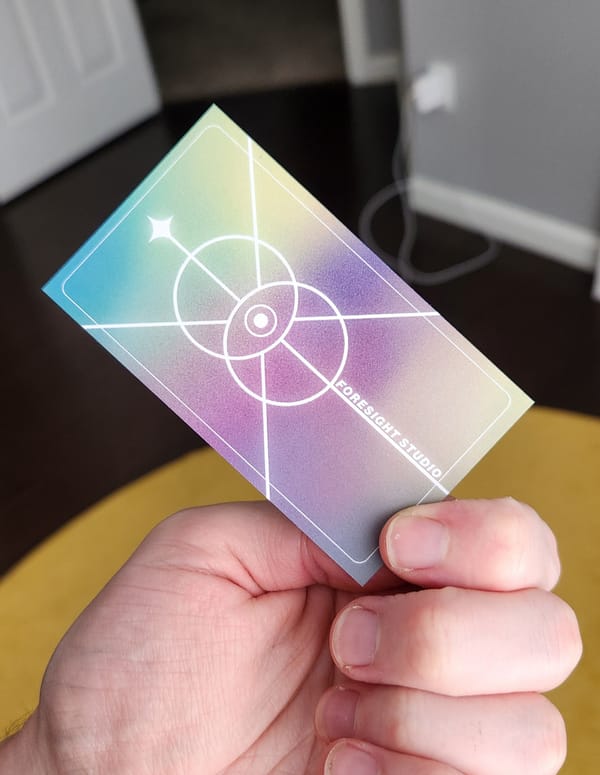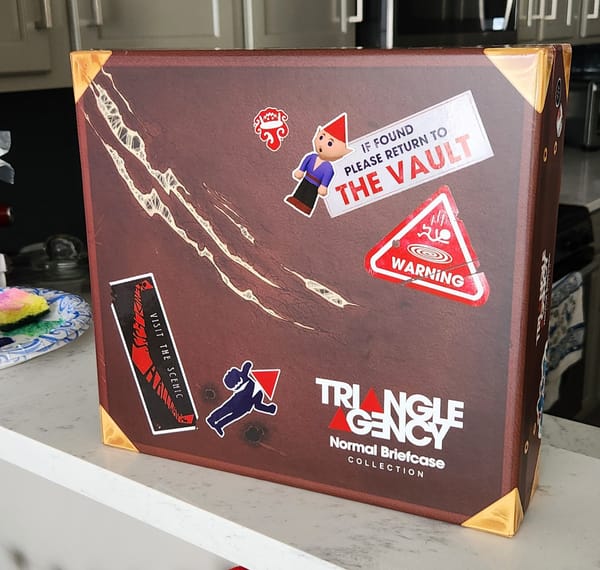A Ghost Story
Spoiler alert: the ghost is you!

An unseen force guiding your every move. An intangible something that seems to be missing behind the eyes of nearly everyone you’ve ever known. A whisper in your ear that congeals on your tongue, spills out your mouth—words you don’t recognize, spoken in your voice.
Being a player character seems kind of rough. But more on that later.
We’re officially waist-deep in spooky season, which means it’s time for us ghouls and gremlins and dark-sided demons to crawl out of our little holes and engage in dastardly antics (i.e., bake pumpkin-flavored desserts, wander corn mazes, pick apples, roast squash and so on). And maybe it’s a coincidence1, but lately I’ve been thinking about ghosts. In this month’s newsletter, I’ll share some thoughts on the possibly definitely haunted relationship between player and PC, and games that poke at that relationship. First, though, what’s new at the studio?
You might have noticed there was no September newsletter. That’s because September didn’t happen. You imagined it. Anyway, here’s what I’ve been up to:
- I finished up layout for the (fully playable) preview of The Silt Verses RPG, out now on The Gauntlet Patreon! Full version coming soon.
- I finalized a few things for the Unofficial Brindlewood Bay Mysteries Anthology, also out now on DriveThruRPG! In Volume 1, you’ll find a new, revised edition of my mystery I Singe the Body Electric (alongside a bunch more wonderful work from wonderful writers).
- I drafted a mission for Triangle Agency that I can’t wait for you to see (later this calendar year, hopefully)!
- I tweaked a few last things on the text of Hillbrook Glen: Follow your Bliss before moving to layout.
- I made arrangements to go to PaxU in December! Maybe I’ll see you there?
- Mostly, I survived.
Also a reminder that The Cross Stitch, my folk-horror adventure for MÖRK BORG, is still available in print from a couple of retailers, or on DTRPG & itch.io in digital form. It’s perfect for this time of year!
Now, about those ghosts. (PS, this newsletter contains spoilers for Baten Kaitos.)

Like a man possessed
I recently started playing Beyond: Two Souls, a video game from a while ago by Quantic Dream. Full disclosure, I’m not very far into it, and I’m not sure it’s a good game (though Elliot Page is giving). Interesting, definitely, but the jury’s still out on “good.” Regardless, it raises some cool ideas about the player-protagonist relationship.
The premise of Beyond: Two Souls is that Jodie, the main character, has an invisible entity tethered to her, an entity that can influence the world around her in ways that defy the laws of physics (and, sometimes, common sense). As the player, you spend most of your time piloting Jodie in third person—until she mutters “help me Aiden” under her breath, and you’re suddenly floating around the scene in first-person perspective, given (kind of) free reign to do what you please.
Early into the game, it’s not clear to me if the intention is to portray Aiden as a stand-in for the player, or if this entity will develop their own personality and point of view eventually. But by and large, Jodie acts how Jodie wants (with a bit of a nudge from the player), while Aiden is a blank slate, under the player’s full control. You are not the protagonist; you just haunt them.
In a way, it’s reminiscent of Baten Kaitos: Eternal Wings and the Lost Ocean. In this 2003 JRPG for Gamecube, you also don’t really control the protagonist, Kalas. I mean, you do—you move the joystick and he walks around, you choose his actions in battle, sell items from his inventory, all the normal video game stuff. The core conceit, though, is that you aren’t Kalas, but rather an invisible “guardian spirit” that guides him. In practice, it mostly just means he breaks the 4th wall every now and then to chat with the player. Until it turns out (spoiler) he was sneaking around behind your invisible back all along, and he betrays you, joining the antagonist’s side.
By throwing this plot twist the player’s way, Baten Kaitos toys with the divide between player and protagonist. As the player, you don’t control the story. You don’t even control the main character. In both Baten Kaitos and Beyond: Two Souls, you’re a ghost.
But is that really any different from games where you are ostensibly in control? You visit a character’s reality, pilot them for a bit, then retreat back to your realm. And if you have unfinished business in the world of the game, well, you’ll be back to haunt them a bit more later, when you have time.2
The thing is, the world of a video game was written by someone, created for you to haunt at your leisure. What about games that unravel at the table in real-time? What about TTRPGs?
Ghost in the character sheet
When you make a character, you make an extension of yourself. They could be as different from IRL-you as you could possibly imagine, but it was still you who imagined them. So, it makes sense that it gets a bit harder to pull apart player and player-character in the context of TTRPGs. The voice at the table is your voice. The face at the table is your face. That’s why bleed is a thing.3
Of course, they’re not you. Their entire existence is defined by some stuff you wrote on a a sheet of paper (or like, five sheets if you’re playing Pathfinder). Depending on the system you’re playing, they may have been cobbled together from pre-written options, a kind of Frankenstein’s monster built from whatever the game’s author found most valuable.
Through play, though, the relationship between player and character changes. You animate your character, embody them, give them a soul. But inevitably, you see and hear things your character does not. Like Aiden in Beyond: Two Souls, the player’s perspective wanders wherever the action goes. When the party splits, you know what your companions are up to even when your character is in the dark.
You’re still a ghost.4
I only know of a few TTRPGs that explicitly poke at the relationship between players and their characters, but the most straightforward example is DIE RPG. In DIE, players create Personas, everyday people reconvening for… a session of a tabletop roleplaying game. These Personas are sucked into a real-life version of the game they’re playing, taking the form of their characters (Paragons, in DIE terminology) and facing down sinister manifestations of their Persona’s fears and failures.
First and foremost, DIE toys with the idea of bleed. It leverages the connection between Persona and Paragon to generate emotional catharsis and keep stakes high. It asks what would happen if we weren’t separate from our characters, using the fictional Persona to do the bleeding for the player. And at the end of the session, you put down the character sheet and go home, (hopefully) bleed-free.
DIE recognizes that some of the most powerful, emotional moments at the table happen when players and their characters overlap. But it also recognizes that the player-character boundary needs to be treated with care and respect. Perhaps a TTRPG could leverage the player’s ghostly presence to turn up the resonance with their character, while directly addressing that a veil does exist between them—a veil that isn’t to be crossed except in specific, regulated circumstances.
Here’s a few ideas I think are kinda cool.
A game in which you haunt several characters over the course of play, jumping between them, bringing something of yourself to each.5
A game in which the mechanics provide a way for your character to betray you, or for you to betray your character (thanks, Baten Kaitos)!
A game that recognizes the meta-knowledge the player has of goings-on at the table (or even outside of it), and allows the character access to this information within the fictional world of the game.
A game in which players take turns possessing each other’s characters (like the powered character in Kids on Bikes, or John in Everyone is John, but if every member of your party was John).
If you know of any games that work like these, let me know!
So, the next time you step into character, maybe you’ll think of this spooky little half-baked metaphor. Or maybe, when you leave the table… your character will haunt you back.
Looking to the future,
Ben // Foresight Studio
As always, would love to hear what you think. Find me on tumblr or twitter (or cohost or bluesky or mastodon, all of which overwhelm me so no guarantee I’ll be posting much there), or come chat on the Foresight Studio discord server.
It’s not. ↩
I think this is especially pronounced in games with multiple protagonists, like Pathologic or Odin Sphere, where you transmigrate between characters, visiting each of their perspectives in turn. ↩
Bleed, or emotional bleed, is a term first coined in the LARP community that describes the transference of feelings from your in-fiction character to your real-life self. While it can lead to some really beautiful & immersive moments in roleplay, it can also get… bad. So use safety tools! ↩
Or, perhaps, a minor god in a pantheon of players, angling for narrative control. (Actually I think this metaphor works better, but, it’s October, so I’m going with the ghost thing.) ↩
Kind of a more contemporaneous take on Legacy: Life Among the Ruins. Even better if the characters you leap between are initially poised as protagonist & antagonist. ↩




